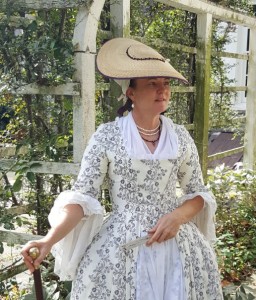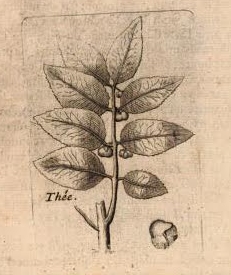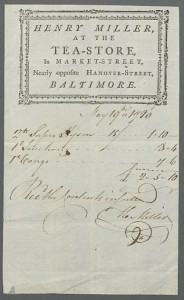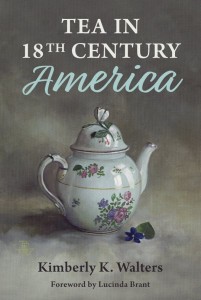Historical nonfiction author Kimberly Walters provides a window into the social and political life of 18th-century America—via tea.
###
 Relevant History welcomes back nonfiction author Kimberly K. Walters, who started reenacting as a hearth cook in 2009 as the Washington Headquarters housekeeper, modeled after Mrs. Elizabeth Thompson. A Book of Cookery by a Lady (2014) is a tribute to Mrs. Thompson. An avid horse woman, animal lover, and historian, Kim is a member of the Fincastle Chapter, the National Society Daughters of the American Revolution in Kentucky. At K. Walters at the Sign of the Gray Horse, she sells reproduction and historically inspired jewelry to care for her rescued and Colonial Williamsburg retired horses. Tea in 18th Century America was released on 17 July 2019. To learn more about her and her books, visit her web site, and follow her on Facebook, Twitter, and Instagram.
Relevant History welcomes back nonfiction author Kimberly K. Walters, who started reenacting as a hearth cook in 2009 as the Washington Headquarters housekeeper, modeled after Mrs. Elizabeth Thompson. A Book of Cookery by a Lady (2014) is a tribute to Mrs. Thompson. An avid horse woman, animal lover, and historian, Kim is a member of the Fincastle Chapter, the National Society Daughters of the American Revolution in Kentucky. At K. Walters at the Sign of the Gray Horse, she sells reproduction and historically inspired jewelry to care for her rescued and Colonial Williamsburg retired horses. Tea in 18th Century America was released on 17 July 2019. To learn more about her and her books, visit her web site, and follow her on Facebook, Twitter, and Instagram.
*****
Tea in 18th Century America focuses on the beverage in the American colonies during the eighteenth century. The only other person to write about this topic was Rodris Roth in the 1960s. Tea in 18th Century America is an expansion of a chapter of A Book of Cookery by a Lady, published in 2014.
 In America, tea was much more than just a drink, and the book gives the reader insight into the importance of tea in the Colonies and early Federal eras. The book begins with an introduction to the history of tea, its journey to the shores of America tracing its ebbs and flows in popularity, and the cultural meaning attached to its use. Then, while giving credit to the research done by Rodris Roth, I added extensive research utilizing period newspapers, historic texts, period portraits, and prints to immerse the reader in their world.
In America, tea was much more than just a drink, and the book gives the reader insight into the importance of tea in the Colonies and early Federal eras. The book begins with an introduction to the history of tea, its journey to the shores of America tracing its ebbs and flows in popularity, and the cultural meaning attached to its use. Then, while giving credit to the research done by Rodris Roth, I added extensive research utilizing period newspapers, historic texts, period portraits, and prints to immerse the reader in their world.
 Tea in pre- and post-revolutionary America was a symbol of tyranny or patriotism and helped create an American identity. At first, I did not want to go in-depth on the explanation of the legal acts and taxes on commodities that set the stage for Americans’ outrage over the monopoly held by the East India Tea Company on tea. However, I felt it an essential and necessary part of this story. The acts and taxes led to the drop in popularity of tea as revolutionary sentiments grew. To drink tea became a political act, although that seemed only to be the case for imported tea. The tea ceremony was still being practiced, albeit with herbal tea as a substitute. Also tea was still being ordered for import, but we do not know if it ever made it to those who ordered it.
Tea in pre- and post-revolutionary America was a symbol of tyranny or patriotism and helped create an American identity. At first, I did not want to go in-depth on the explanation of the legal acts and taxes on commodities that set the stage for Americans’ outrage over the monopoly held by the East India Tea Company on tea. However, I felt it an essential and necessary part of this story. The acts and taxes led to the drop in popularity of tea as revolutionary sentiments grew. To drink tea became a political act, although that seemed only to be the case for imported tea. The tea ceremony was still being practiced, albeit with herbal tea as a substitute. Also tea was still being ordered for import, but we do not know if it ever made it to those who ordered it.
Enjoying tea required all types of “material culture” items: teapots, spoons, tea chests, cups, saucers, slop bowls, specialized spoons such as “mote spoon” and “tea scoop” specifically for the tea caddy, and various other items that were markers of class and financial status. Taking tea was often a performative act in social settings, with rules to be followed and customs to be learned. Tea was so much more than a delightful hot beverage, and it was not only “taken” with sweets as a side dish.
I included chapters on when during the day people in eighteenth-century America drank tea, and the types that were popular. There are instructions on understanding eighteenth-century recipes as well as identifying foods that are perfect to prepare and eat when having your own tea party. From breads and small cakes to dessert collations—there are notes for each recipe to help prepare them. I have also included descriptions of how food was given color and even how medicinal teas were used to cure an ill.
A bonus chapter focuses on the life of Margaret Tilghman Carroll, widow of Charles Carroll “the Barrister.” While living at Mount Clare in Baltimore, Maryland, Mrs. Carroll kept an account book that included an inventory on tea items she owned, and she wrote recipes within it. That book is preserved in the Maryland Historical Society library.
*****
 A big thanks to Kimberly Walters! She’ll give away one hardcover copy of Tea in 18th Century America to someone who contributes a comment on my blog this week. I’ll choose the winner from among those who comment by Friday at 6 p.m. ET. Delivery is available worldwide.
A big thanks to Kimberly Walters! She’ll give away one hardcover copy of Tea in 18th Century America to someone who contributes a comment on my blog this week. I’ll choose the winner from among those who comment by Friday at 6 p.m. ET. Delivery is available worldwide.
**********
Did you like what you read? Learn about downloads, discounts, and special offers from Relevant History authors and Suzanne Adair. Join Suzanne Adair’s Patreon, and subscribe to her free newsletter.

I was basically born and bred a coffee drinker, but now that I’m living in the South, I find myself in a world of tea drinkers…granted, most of it is iced tea. But I’m also fascinated by history and can just imagine the number of research rabbit holes you explored to produce the book. Congratulations on the release of “Tea in 18th Century America, and best wishes for great sales and reviews. (And if that’s you in that dress and hat, gorgeous!)
Thank you so much! There were lots of rabbit holes! I grew up drinking sweet and unsweet tea both hot and cold. My introduction of the book goes into that and my father’s influence!
Kim
Very interesting, Kimberly! I know the Boston Tea Party happened, but I didn’t realize how important tea was to the Colonists until I moved to northeast NC and learned about Penelope Barker of Edenton, and how she convinced several other women of the area to rebel against the tea tax. Would love to read the book–I recently started following you (as an admin for Outlander NC), and love your informative posts.
Thanks, Suzanne, for hosting Kimberly!
Hello Susan,
The ladies of Edenton are in my book, along with letters from a relative in England and his opinion of it all. I think you will love the book, and thank you for following me!
I think you will love the book, and thank you for following me!
Kim
Being brought up by my English grandparents I have always had afternoon tea with small cakes or sweets. I would love to read your book. I am an reenactor belonging to the 49th regiment of foot British unit.
Wonderful Carlene! Sweets are a part of tea in any century; however, the staple in the 18th was bread and butter. Then add what you will from cheese, meats, sweets, fish, etc. Lots of info in my book with primary sources cited as always!
Kim
The British certainly set themselves up for revolt. We lived in Boston where the Tea Party is viewed as a symbol of the colonists growing dissatisfaction with British rule. We now live in Hillsborough, North Carolina, where the Regulator Rebellion was launched in opposition to the tax collectors demanding money from cash poor farmers. It’s all about money and power.
Hello Nancy,
The issues at hand with the Townsend Acts, Stamp Act, and Tea Act of 1773 affected all of the colonists. I definitely go into it in my book.
Kim
I absolutely loved A Book of Cookery by a Lady and gifted to many good friends. It inspired me to learn more about hearth cooking and I hope to attend a class on it in 2020. Tea is one of my favorite things, both the taste and the preparation ritual, so I know I will enjoy this book immensely. Thank you for your fabulous research on the subject and all the good you do for the horses.
Thank you Sarah for the kind words! It is very appreciated. The funny thing about A Book of Cookery is that it is really focused on foodways of the 18th century and not really hearth cooking – that is just how they prepared their dishes. It includes how to set a table, how to pick your fruits, veggies, meats, etc., at market, cleanliness, etc. There is a chapter about tea in there and my new book expands that small chapter!
It includes how to set a table, how to pick your fruits, veggies, meats, etc., at market, cleanliness, etc. There is a chapter about tea in there and my new book expands that small chapter!
Kim
It inspired me by getting me started watching historical cooking shows like Taste of History which got me interested in hearth cooking. Funny how inspiration works! Even more excited to hear that it will be touched on in the new book!
Awesome! I must admit, I have not seen any of the Taste of History shows – I do not get but basic TV nor subscribe; however, Chef Staib actually has my Book of Cookery by a Lady and wrote a wonderful review for me! All of the receipts can be made at home using my reference area on cooking terms and measurements.
Tea seems to be a sweet and innocent topic for a book, but you have managed to include all of the history, politics and intrigue as well. Well done!
Thank you Donah! Your kind words are greatly appreciated. It is a beverage that I think it is safe to say was not only a precious thing to the colonists, but a drink that was both socially, politically, and economically important. Can any other drink claim that status?
I am fascinated by the difference in the tea drinking and other domestic ceremonies of civilisation in England and the colonies. So often things remained culturally entrenched in a colony as a social standard while those in England evolved new fashions of civilisation, but sometimes the reverse was true and often for local political reasons.
Kimberly will have had her work cut out in her research to sort fact from fable. For example, was the Boston Tea Party provoked by the British imposing taxes or by them reducing the taxes to put the colonial smugglers out of business? The financial aspirations of the colonial gentleman were every bit as influential as the social aspirations of their ladies.
This will, I am sure, be a fascinating cultural read and I would be honoured to receive a copy. If I win and you don’t mail to UK let me know and I will fund postage.
I think you will be surprised by my book Nigel – it is pretty much all from primary sources – newspapers, letters, diaries, probate records, wills, etc. Whomever is chosen to win will receive a copy of the book no matter where they are! I did not want to leave out our international readers.
Kim
Very interested in this! I began my journey into living history and the 18th century when I worked a few years at the Boston Tea Party Ships & Museum. Needless to say, we were crazy about all things 18th C tea! I still consider the Tea Crisis one of my areas of specialty. I will certainly recommend it for their research library. Let me know if I can help you get in touch with their gift shop manager as well. This seems a perfect addition!
Thank you Christopher! I am sure we would have a lively discussion. I reached out several times to the tea museum in Boston with no response. Boston was immeasurably important to the story. You are welcome to e-mail me with further details.
That looks like an amazing resource!
If I didn’t write it, I would definitely think so! I also use it as a guide when preparing for an event and serving tea.
I recently read a book that included writings of Benjamin Franklin’s sister – actually mostly hers. A money making project she tried failed when tea drinking became politically opposed. It’s unbelievable, well, not really, how such things affect our history.
There were a few others besides that – including growing it and processing it here…
Though I am not a tea drinker, its importance to the colonists, and thus American history, cannot be understated. And that is why this book is so interesting to me!
Thank you for writing it!
Thank you Ken! I grew up drinking tea and still do. Love it as my father did.
Love learning about the history. As a Southerner, I grew up on “sweet tea” but it was served cold. We drank coffee as a hot beverage. However, my daughter introduced me to the wonderful benefits of sting hot tea. I am now a huge fan and love learning about the accoutrements. Yes, we Southerners still love dressing things up! Hope I can find some of the items used by previous generations.
There are many places that you can get original and reproduction items for taking 18th century tea.
This book is definitely on my wishlist, and now I want it even more! It sounds like there is a ton of information in!
Hey Trisha! So glad you commented, and I know you in particular will love it.
This is on my Christmas list! I’ve been loving Eliza’s posts about the various recipes and things shes learned and it definitely sounds like a must for anyone interested portraying an upper class woman.
It is a must have for anyone portraying any level of society for 18th century living history. Anything that affected the upper classes definitely affected the lower – including indentures and slaves. Those in the lower classes always wanted to better themselves and emulate the upper classes, so it would be sure to say that they also drank tea albeit probably used tea leaves or the littler bits/dust. There are many prints showing the lower classes having a cup of tea, so I would not pigeonhole this into an upper class impression book. 😉
Different continent, different war but your post reminded me of Corrie ten Boom’s description, in The Hiding Place, of stretching used tea leaves with rose petals and the confiscation of a package of tea by Nazi troops. Small pleasures loom large in wartime.
Indeed! There can be a lot of correlations. I actually have a ration book from my Mom during WWII and other items that were left that she saved.
I would love to win a copy of this book! I am a life-long tea drinker and like it any temperature! I hope the book includes a reference to the only tea grown in America in South Carolina with plants brought here in the 1700s and also that there was a tea party in Charleston – but they kept the tea and sold it to raise money for supplies needed for the Revolution!
There were protests throughout the colonies in solidarity to what happened in Boston. There is reference to possibly growing tea here in the colonies as a solution to their issue, but it wasn’t successful and my reference was not in South Carolina but that doesn’t mean the other colonies were not doing their part or trying. In most cases, the tea was discarded in some way or hidden. But, I never say never.
I revise my comment – my reference IS to South Carolina!
We are still growing tea commercially here near Charleston! With the descendants of those 18th-century plants. It is the only tea grown in America.
I think I started drinking tea as a teen-age act of rebellion against my family who were “dyed-in-the-wool” coffee drinkers. In my college days I drank some pretty foul cups of tea involving really cheap brands of teabags. Now I have access to leaf teas and drinking tea now is always a pleasure. While I wish to win a copy of your book Kimberly, I will have one – even if I have to wait to buy one at Fort Frederick!
Thank you Thomas! I grew up drinking tea, and love coffee as well. If you do not win the book, I do mail order! My book is available within my Etsy shop.
I received your book as a gift myself and have already put it to great use as an educational resource for kids. I would love to gift a copy to someone I know who would also make great use of it.
Thank you Melodie! What you did with the Children of the American Revolution was amazing. I do hope that more DAR chapter or even the HQ decides to pick this book up for sale as not only am I a member of the Fincastle Chapter of the DAR, but I wrote about a topic that many of our first daughters would have been familiar with in living it!
Looks interesting, I’ll check it out!
Wonderful! You can read more about it above and on my blog/website. http://www.kwaltersatthesignofthegrayhorse.com
This is a wonderful book and I’m so tickled to see it featured on a blog! My mom and I own Kimberly’s “A Book of Cookery by a Lady” and have enjoyed it and her latest thoroughly. It’s a lovely book that I’d love to gift to one of my dear friends.
Thank you so much for the kind words!
Thank you everyone who commented on this blog post! Ken Giorlando was notified by Ms. Adair that he won the free book. I have limited stock of books in at the moment, so please – if you are interested in one signed by me – please order from my Etsy shop asap!
Kim